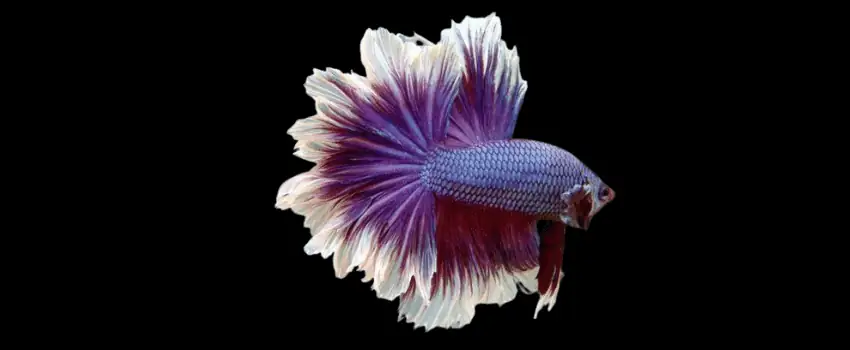Feathertail bettas are gorgeous fish with large, ruffled fins and tails. They’re a variation of rosetail bettas and have more extreme branching in the tail.
The rosetail betta was discovered in 1989 by Rajiv Masillamoni and Laurent Chenot. In 1991, Jeff Wilson gave the betta its name.
A genetic mutation led to a very similar-looking betta: the feathertail betta. The mutation occurred through halfmoon betta breeding.
Nowadays, feathertail bettas are bred for their appearance and commercial sale.
Most betta fish breeders avoid breeding this one. This betta species tends to have health issues and other concerns due to its genetics.
If you plan on getting a feathertail betta, prepare to accommodate its needs.
Table of Contents
Appearance

Feathertail betta fish are a sight to behold.
They get their name from their unique tail appearance. The tail of feathertail bettas has excessive branching of the rays. This gives the tail a feathery and spread-out look.
It’s common for people to confuse feathertail bettas with rosetail bettas. These types of bettas look similar. Also, they both result from mutations in halfmoon betta breeding. But feathertail bettas feature even more branching than rosetail bettas do.
Feathertail bettas come in a wide range of colors and patterns. You’ll find them bi-colored, multi-colored, and even marbled.
Unique Differences
Unfortunately, many betta enthusiasts discourage the breeding and owning of feathertail bettas.
This betta type results from a genetic mutation. The mutation causes excessive branching of the tail, which poses different issues:
- Possible age-related health issues. Feathertail bettas often have failing health as they age, more than other betta types. This is due to the genetic makeup of the fish.
- Difficulty swimming. The branching in the betta’s tail makes swimming more difficult. It increases the weight and size of the tail and fins. This is troublesome because bettas need to swim to the water surface for oxygen. They also must swim up to eat during feeding time. The excessive size of their tail and fins prevents them from doing so.
- Tail and fin nipping. Feathertail betta fish often become frustrated with their own tail and fins. To take care of the issue, they sometimes nip or bite at their own tail and fins. This can result in injuries and infections, reducing your betta’s lifespan.
- Greater chance of infection or disease. These bettas are especially prone to diseases and infections of the tail and fins. Fin nipping may result in open wounds which become infected. Further, their longer and heavier finnage is more prone to diseases such as fin & tail rot.
- Tail collapse. In extreme situations, the tail actually becomes heavy enough to collapse. This is a major health concern, often resulting in the betta no longer being able to swim.
All these issues cause feathertail bettas stress and decrease their quality of life.
But with the proper care and attention, your feathertail betta can live a decent life.
Lifespan
Due to the factors mentioned earlier, feathertail bettas have short lifespans.
On average, they can live anywhere from 1 to 3 years with proper care.
Average Size
The average feathertail betta grows to be from 2.5-3″ inches long.
They may appear larger than this due to their impressive tail and fins. Feed your betta fish a balanced and nutritious diet to help it reach its full size potential.
Feathertail Betta Fish Care
Feathertail bettas are somewhat difficult to care for. They need some special attention and consideration due to their tail and fins.
Tank Size
This type of betta needs a tank size of at least 5 gallons. We recommend a larger size of 10 gallons, though, to accommodate their tails and fins.
If you plan on adding tank mates, increase the tank size accordingly.
Water Parameters
Like other betta varieties, feathertail bettas need specific water parameters to thrive:
Ideal Water Parameters for a Betta Fish Tank Include the following:
- Temperature: 78-80° degrees Fahrenheit (25.5-27° C)
- pH: 6.5-7.5
- Ammonia and Nitrite: 0 ppm
- Nitrate: < 40 ppm
- gH: 3-4 dGH (50-66.7 ppm)
- kH: 3-5 dKH (53.6-89.4 ppm)
- Minimum Tank Size: 5 Gallons
Keeping the betta tank at a consistent temperature and pH is essential. Bettas experience shock when the water conditions change too fast.
We recommend getting a tank water heater and some aquarium testing strips.
What To Put In Their Tank
Your betta will need the following in its tank setup:
- A neutral-colored substrate or gravel
- A low-flow tank filter, preferably baffled to prevent fin or tail injury
- Proper aquarium lighting
- Live plants or plant decorations
- Tank decorations, especially those with hidey-holes
Possible Diseases
Feathertail betta fish are prone to many of the same diseases as other betta species. These include, but are not limited to, the following:
- Ich
- Dropsy
- Swim bladder disease
- Columnaris
- Popeye
- Tail & fin rot
- Flukes
- Anchor worms
This betta type is especially prone to tail- and fin-related issues. These include tail & fin rot, infections from injuries, and parasites.
Always keep the water conditions stable and feed your betta a balanced diet.
Food & Diet
Betta fish need a nutritious diet containing plenty of protein and fiber.
We recommend feeding your betta a variety of food types for the best results:
- Live. Bettas enjoy live foods such as bloodworms, brine shrimp, and insect larvae. These foods provide ample protein and other nutrients. But they tend to be more expensive and difficult to handle than other options.
- Frozen. Many betta keepers prefer using frozen foods instead of live foods. They offer plenty of nutrients while costing less and being easier to handle. Both live and frozen foods make a good occasional treat for bettas.
- Freeze-dried. This option is somewhat more affordable and convenient than the two above.
- Pellets and flakes. When buying pellets or flakes, ensure they’re made specifically for betta fish. Most bettas prefer pellets over flakes, but they’ll usually eat either one.
A proper diet is crucial to the health of your feathertail betta. Due to its proneness to various health issues, it needs adequate nutrition to thrive.
Behavior & Temperament

This betta species has a similar temperament as others.
Feathertail bettas tend to be aggressive and territorial. For this reason, male bettas should only live alone or with suitable, non-betta tank mates.
There are other reasons why your feathertail betta might show signs of aggression:
- Disease or infection
- Stress
- Poor water conditions
Consider moving your betta to a separate tank if you notice aggression issues. Other options include adding more hiding places to the tank and buying a larger tank.
Tank Mates
Feathertail bettas usually do well with tank mates. But ensure you choose these tank mates with care.
Avoid housing your betta with large or aggressive tank mates, including other bettas. Also, avoid tank mates known for fin-nipping behaviors.
They may damage your betta’s fins and tail, which are already prone to injury and infection.
Some good tank mate options for feathertail bettas include the following:
- Corydoras
- Snails
- Shrimp
If you notice aggression issues or injuries, house your betta by itself.
Breeding
Experts recommend not breeding or buying feathertail bettas.
This betta fish type has genetic risk factors for various health issues. While they have a beautiful appearance, they usually do not live very long.
Feathertail bettas arose from a genetic mutation occurring in halfmoon betta breeding. It’s difficult to breed a perfect feathertail betta. Most betta breeders avoid this one.
If you insist on having a feathertail betta, get it from a responsible betta breeder.
Price
On average, a single feathertail betta fish will cost from $15 to $20.
The exact price may vary based on different factors.
For example, bettas featuring rare colors or patterns may cost more. Those with especially impressive finnage may also rack up the price.
Rarity

Feathertail bettas are somewhat rare in the betta-keeping world.
Most betta breeders avoid breeding feathertails. This is due to their poor immune systems and genetic risk factors.
While feathertail bettas are available, they’re difficult to come by.
When they are available, they tend to have much shorter lifespans than other bettas. They also struggle with health issues throughout their lives.
Certain types of feathertail bettas may be rarer than others. Those with rare colors and especially beautiful finnage are usually harder to find.
Feathertail Betta Fish FAQs
What is the difference between feathertail and rosetail bettas?
Feathertail bettas and rosetail bettas are very similar in appearance. Some people refer to them as the same species, while others do not.
The primary difference is: feathertail bettas have more extreme branching than rosetails.
How much is a feathertail betta?
A feathertail betta costs, on average, between $15 and $20.
It might cost more if it features rare colors or patterns. The cost may also increase if the betta is especially healthy or from a reputable breeder.
What does a feathertail betta look like?
Feathertail bettas are one of the most beautiful betta fish types.
They feature large, heavy fins which experience “branching.” This branching gives the fins and tail a feathery or ruffled appearance.
These bettas come in various colors and patterns.
They may be unicolor, bi-color, multi-color, or marbled. Popular colors include white, pink, blue, red, and black.
Give Your Feathertail Betta the Best Possible Care
Feathertail bettas are beautiful fish but have their share of health problems.
If your heart is set on caring for one, you’ll need the best guides, advice, and products at your disposal.
We’re committed to bringing you the best in betta fish care.
If you found this article helpful, please share it on social media. And keep following us for great, betta-centered content.


